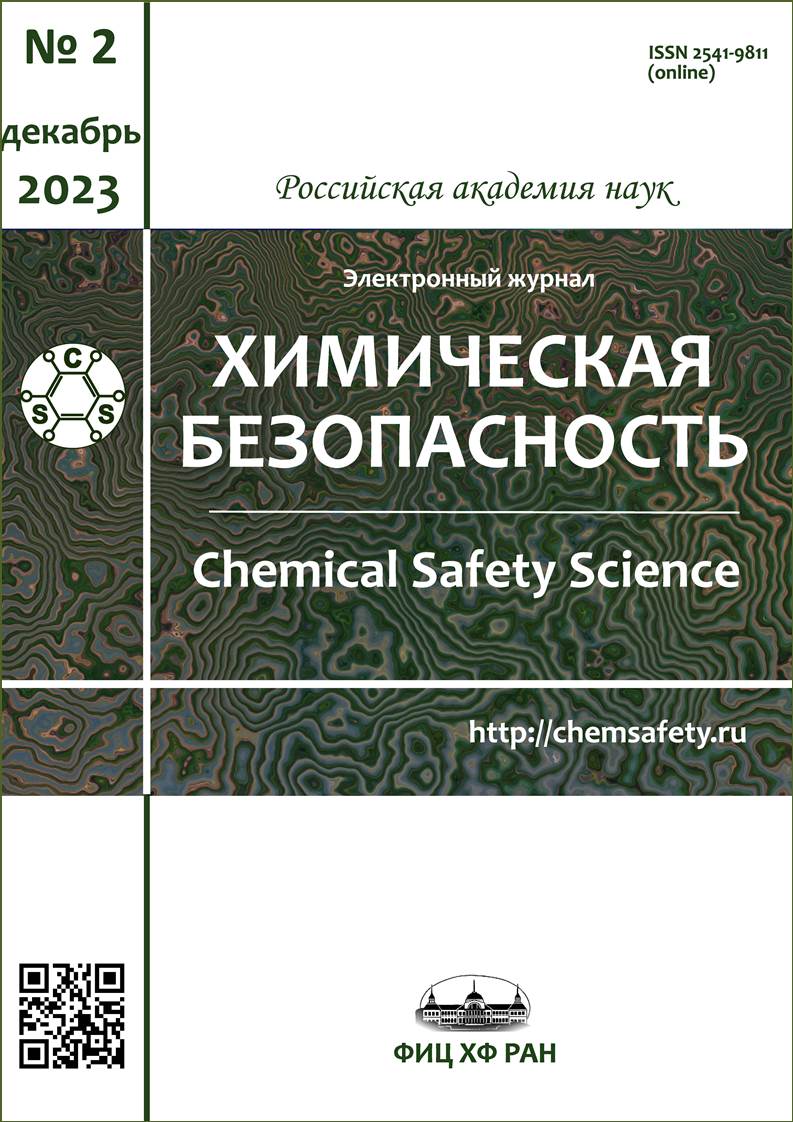Совершенствование подхода к аналитическому контролю мышьяка и его соединений. Апробация на реальных объектах
Аннотация
Анализ литературных источников показал наличие «слабых» мест при аналитическом контроле мышьяка в объектах ихтиофауны и водорослях, используемых в пищевой продукции. Для формулирования заключения о качестве рыбы необходимо выявления форм нахождения мышьяка: либо неорганическая (наиболее токсичная), либо органические соединения, являющиеся токсически инертными или малотоксичными. В результате проведения мониторинговых исследований было выявлено, что наибольшее валовое содержание мышьяка обнаружено в ламинарии – 1,510 мг/кг, при этом и доля неорганической формы самая высокая – до 70,5 % от всего количества мышьяка. В других образцах неорганический мышьяк не обнаружен. Во всех исследуемых образцах не обнаружено соединение ММА. Доля ДМА зависит от среды обитания и источников питания.
Литература
Nemova N.N., & Vysotskaya R.U. (2004). Biochemical indication of fish condition. M.: Nauka, 215 p. (in Russ.)
Fowler B. A., Chou C. S. J., Jones R. L., & Chen C.J. (2007). Handbook of the toxicology of metals (3rd ed.). Burlington: Elsevier.
Komorowicz I., & Barałkiewicz D. (2016). Determination of total arsenic and arsenic species in drinking water, surface water, wastewater, and snow from Wielkopolska, Kujawy-Pomerania, and Lower Silesia provinces, Poland. Environ Monit Assess, 188(9), 504(2016). https://doi.org/10.1007/s10661-016-5477-y.
Cima F., Craig P., & Harrington Ch. (2003). Organometallic compounds in the environment. USA: John Wiley & Sons Ltd, Inc. https://doi.org/10.1002/0470867868.ch3.
World Health Organization (2011). Guidelines for drinking water quality, 4th ed. Switzerland: WHO.
COUNCIL DIRECTIVE 98/83/EC of 3 November 1998 on the quality of water intended for human consumption. (1998). Official Journal of the European Communities, L 330/32, 32 p.
SanPin 1.2.3685-21. Hygienic norms and requirements to ensure safety and (or) harmlessness of environmental factors for humans, 2021. 677 p. (in Russ.).
Mandal B., & Suzuki K. (2002). Arsenic round the world: a review. Talanta, 58, 201–235. https://doi.org/10.1016/S0039-9140(02)00268-0.
Paikaray S. (2012). Environmental hazards of arsenic associated with black shales: a review on geochemistry, enrichment and leaching mechanism. Rev. Environ. Sci. Biol., 11, 289 – 303. https://doi.org/10.1007/s11157-012-9281-z.
Villaescusa I., & Bollinger J. (2008). Arsenic in drinking water: sources, occurrence and health effects (a review). Rev. Environ. Sci. Biol., 7, 307–323. https://doi.org/10.1007/s11157-008-9138-7.
Akter K., Owens G., & Davey D. (2005). Arsenic speciation and toxicity in biological systems. Reviews of Environmental Contamination and Toxicology, 184, 97–149. https://doi.org/10.1007/0-387-27565-7_3.
TR/TS 021-2011 «On Food Safety», 2011. 242 p. (in Russ.).
GB 2752-2022. China Releases the Standard for Maximum Levels of Contaminants in Foods https://www.fsis.usda.gov/sites/default/files/media_file/2021-02/GB-2762-2017.pdf (accessed 15.05.2023).
GOST 4152-89. Drinking water. Method for determination of arsenic mass concentration, 1991. 7 p. (in Russ.).
PND F 14.1:2:4.221-06. Methodology for measuring the mass concentration of arsenic and mercury ions in drinking, mineral drinking, natural and waste water samples by the inversion voltammetry method, 2006. 22 p. (in Russ.).
Sanchez-Rodas D., Corns W., Chen B., & Stockwel P. (2010). Atomic fuorescence spectrometry: a suitable detection technique in speciation studies for arsenic, selenium, antimony and mercury. J. Anal. At. Spectrom., 25, 933–946. https://doi.org/10.1039/B917755H.
Fiket Z., Roje V., Mikac N., & Kniewald G. (2007). Determination of arsenic and other trace elements in bottled waters by high resolution inductively coupled plasma mass spectrometry. Croat. Chem. Acta, 80, 91–100.
Jackson B. P., Liba A., & Nelson J. (2015) Advantages of reaction cell ICP-MS on doubly charged interferences for arsenic and selenium analysis in foods. J. Anal. At. Spectrom., 30, 1179–1183. https://doi.org/10.1039/C4JA00310A.
Magnusson B., & Ornemark U. (2014). Eurachem Guide: The Fitness for Purpose of Analytical Methods – A Laboratory Guide to Method Validation and Related Topics.
EN 16278:2012. Animal feeding stuffs - Determination of inorganic arsenic by hydride generation atomic absorption spectrometry (HG-AAS) after microwave extraction and separation by solid phase extraction (SPE), 2012. 18 p. https://standards.iteh.ai/catalog/standards/cen/50782c2f-939f-4316-85d3-9f3fa4c7306a/en-16278-2012 (accessed 05.08.2023).
Jin, P., Liang, X., Xia, L., Jahouh, F., Wang, R., Kuang, Y., & Hu, X. (2016). Determination of 20 trace elements and arsenic species for a realgar-containing traditional Chinese medicine Niuhuang Jiedu tablets by direct inductively coupled plasma-mass spectrometry and high-performance liquid chromatography-inductively coupled plasm. Journal of Trace Elements in Medicine and Biology, 33, 73–80. https://doi.org/10.1016/j.jtemb.2015.09.006.
Komorowicz I., Sajńog A., & Barałkiewicz D. (2019). Total arsenic and arsenic species determination in freshwater fish by ICP-DRC-MS and HPLC/ICP-DRC-MS techniques. Molecules, 24(3). https://doi.org/10.3390/molecules24030607.
Yu X., Deng T., Guo Y., & Wang Q. (2014). Arsenic species analysis in freshwater using liquid chromatography combined to hydride generation atomic fluorescence spectrometry. Journal of Analytical Chemistry, 69, 83–88. https://doi.org/10.1134/S1061934814010146.
Hirano S., Kobayashi Y., Cui X., Kanno S., Hayakawa T., & Shraim A. (2004). The accumulation and toxicity of methylated arsenicals in endothelial cells: important roles of thiol compounds. Toxicol. Appl. Pharm., 198, 458–467. https://doi.org/10.1016/j.taap.2003.10.023.
Karadjova I., Slavekova V., & Tsalev D. (2008). The biouptake and toxicity of arsenic species on the green microalga Chlorella salina in seawater. Aquat. Toxicol., 87, 264–271. https://doi.org/10.1016/j.aquatox.2008.02.006.
Petrick J., Ayala-Fierro F., Cullen W., Carter D., & Vasken A. (2000). Monomethylarsonous acid (MMA III) is more toxic than arsenite in chang human hepatocytes. Toxicol. Appl. Pharm., 163, 203–207. https://doi.org/10.1006/taap.1999.8872.
Bondareva L. (2018) Tritium in the freshwater ecosystem of the Yenisei River: behavior, accumulation, and transformation. In: Tritium: Advance in Research and Application. New York: Nova Science Publishers. (pp. 47–98).
GUM. The Guide to the expression of uncertainty in measurement, 2004. 30 p.
Jan A., Benford D., Boobis A., & Ceccatelli S. Scientific Opinion on Arsenic in Food. EFSA Panel on Contaminants in the Food Chain (CONTAM). EFSA Journal, 7(10), 1351. https://doi.org/10.2903/j.efsa.2009.1351.
BS EN 16802:2016. Foodstuffs. Determination of elements and their chemical species. Determination of inorganic arsenic in foodstuffs of marine and plant origin by anion-exchange HPLC-ICP-MS, 2016. 18 p. https://www.en-standard.eu/bs-en-16802-2016-foodstuffs-determination-of-elements-and-their-chemical-species-determination-of-inorganic-arsenic-in-foodstuffs-of-marine-and-plant-origin-by-anion-exchange-hplc-icp-ms/ (accessed 05.08.2023)
Kenyon E.M., & Hughes M.F. (2001). A concise review of the toxicity and carcinogenicity of dimethylarsinic acid. Toxicology, 160, 227–236. https://doi.org/10.1016/S0300-83X(00)00458-3.
Kaise T., Watanabe S., & Itoh K. (1985) The acute toxicity of arsenobetaine. Chemosphere, 14, 1327–1332. https://doi.org/10.1016/0045-6535(85)90153-5.
Copyright (c) 2023 В. Н. Ракитский, Л. Г. Бондарева, Н. Е. Федорова, А. C. Родионов

Это произведение доступно по лицензии Creative Commons «Attribution-NonCommercial» («Атрибуция — Некоммерческое использование») 4.0 Всемирная.









